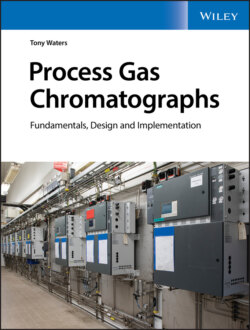Читать книгу Process Gas Chromatographs - Tony Waters - Страница 17
The gas chromatograph The basic instrument
ОглавлениеA gas chromatograph is an analytical instrument that uses the techniques of gas chromatography to measure the concentration of selected chemical compounds in a small sample containing a mixture of compounds.
In a gas chromatograph, the mobile phase is a gas carefully selected for the application. It's usually hydrogen, helium, or nitrogen, but any gas will do the job, as long as is doesn't react with the sample components or the column materials. The gas should not contain oxygen or water vapor, as these substances might damage the columns.
The pressure of the carrier gas is closely controlled, after which it flows continuously through the column.
The analyzed fluid can be a gas or a volatile liquid. A special valve injects a small volume of that fluid into the flowing carrier gas. A liquid sample usually vaporizes instantly upon injection, so it's all vapor by the time it reaches the column.1
Note that when a gas chromatograph accepts a liquid sample, it doesn't become a liquid chromatograph. A liquid chromatograph is an entirely different instrument that employs a liquid mobile phase and separates components in the liquid phase. Liquid chromatographs are rarely employed as industrial online analyzers and are not considered here.
After injection, the carrier gas carries the gas or vapor sample into the column, where it contacts the stationary phase. It's the contact with the stationary phase that accomplishes the desired separation.
It's common to use the word component for a chemical substance or a group of chemical substances that are present in the sample. The gas chromatograph may not measure every component, but each component measured is an analyte.
A gas chromatograph can separate and measure one, several, or all the components in a gas or liquid sample.
After separation, the carrier gas carries the components into a detector that provides a measurable signal to the data‐processing circuits.
When actuated, the sample injection valve transfers a minute aliquot of the sample fluid into the flowing carrier gas. Later chapters provide full details of the many varieties of sample injector valve used in process gas chromatographs.
Figure 1.2 Basic Gas Chromatograph.
Figure 1.2 introduces the essential hardware devices found in any gas chromatograph:
A column oven with one or more controlled temperature zones.
A carrier gas supply and pressure control system.
A sample injector to inject a repeatable volume of sample into the flowing carrier gas.
One or more separating columns.
One or more detectors.
All gas chromatographs have these basic functions, yet we see a large variation in their design and fabrication.
